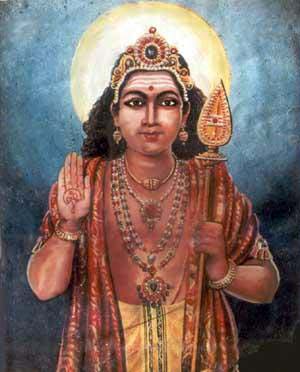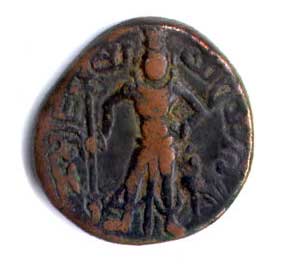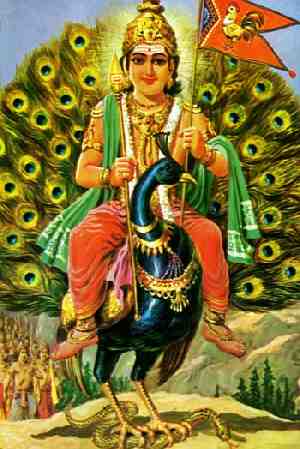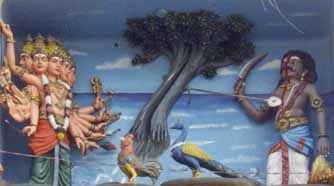
|
||
|
| ||
The Skanda Cult in India: Sanskrit sources
by K.V. SarmaAcculturation is a universal phenomenon that takes place when two rich cultures come together and intermingle, one sumptuous enough to supply and the other capacious enough to absorb. The results are novel and blended patterns ennobling the one and enriching the other. In its broad and extended sense culture encompasses a variety of matters including life style, dress, food-habits and foodstuff, language, speaking habits and appellations, customs and manners, doctines and beliefs, myths and legends, deities and worship and the like. This phenomenon can take extensive strides and elaboration and also supplementation that, at times, the graft outgrows the trunk. A striking instance in point is the acculturation that has taken place in South India, especially Tamilnadu, in the cult of Skanda. For an estimation of the prevalence of the Skanda cult through Sanskrit and, for that matter in North India where it has ceased to prevail from about the 10th century A.D., the potential sources would be vedic literature, the Sanskrit epics and purānas, prose, poetic and drama literature, texts on Dharmashastra and worship of deities, stotra literature, technical texts and inscriptions mentioning the constitution of temples for Skanda. Places of pilgrimage, rivers, groves and ponds sacred to Skanda are also pointers to the Skanda cult in North India. Sanskrit texts mentioning the emigration and spread of the Skanda cult from the North to the South are also informative in the matter. The present paper endeavours to collect relevant information from all these sources and present them in order. Kumāra-Skanda-Kārttikeya in Vedic literatureThe evolution of Kumāra-Skanda-Kārttikeya who, during later times developed into one of the popular and prominent members of the Hindu pantheon, takes its origin from Vedic times. The tradition commences from the Rigveda where Kumāra appears as related to god Agni as his father, a feature carried forward down the tradition. Thus Rigveda 5.2.1-3 mention Kumāra as endowed with golden teeth and golden complexion who had been secreted by his mother in a cave (guhā) -- a feature current in later tradition also -- out of sight of his father1. Again, Agni is said to have seven auspicious mothers (RV 1. 141.2)2 and also born of seven mothers3, aspects which betray resemblances to the purānic Skanda. In the Kāthaka Samhitā of Krsna-Yajurveda the birth of Kumāra in Agni is made mention of (36.5) and also his exploits (19.11). In the Śatapatha Brāhmana (6.1.3.8-10) there occurs a symbolic account of the birth of Kumāra. It is said that the six bhūta-s are the six seasons, their lord is the year (samvatsara) and they drop their seed at dawn, which, after a year, gives birth to Kumāra who is equated with Rudra, bring another traditional name of Skanda4. Elsewhere the same Brāhmana states (6.1.3.18) that Agni born as Kumāra had nine names, of which the ninth is Skanda. This Brāhmana equates the Krittikā-s with Agni (2.1.2.5).5 Again, the same Brāhmana states elsewhere (6.1.3.18) that Agni born as Kumāra is given nine names, of which the ninth is Skanda. The Maitrāyani Samhita of the Krsna - Yajurveda contains a Skanda-gāyatrī where three of his names occur: Tat Kumārāya vīdamahe Kārttikeyāya dhīmaī / tannah Skandah pracodayāt // The Taittirīya Āranyaka, in Prapātmaka 10, has a variant form of Skanda-gāyatrī which reads : tat Purusāya Vidmahe Mahāsenāya dhīmahī / tanno Sanmukhah pracoyaāt//.
The Siddhāntashikhopanisad portrays Skanda as Bhagavān and as a teacher.6 The Śivopanisad instructs the installation of the image of Skanda and the Mother Goddess near the Śivalinga.7 The Atharvasira-Upanisad also makes a mention of Skanda but identifies him with Rudra.8 Among the ancillary texts related to the Atharvaveda, the Atharva-parishista-s, one of the texts entitled Dhūrtakalpa or Sanmukhakalpa9 is an elaborate ritual on the propitiation of Skanda through homa (offerings in the sacred fire) and worship of his image with flowers, incense, lamps and sandal and offerings of naivedya (eatables). His names are mentioned as Skanda, Sadānana, Kārttikeya, BrahmĀnya, Svāmī and Dhūrta, the last meaning 'rogue' or 'master thief'! He is described as riding a peacock (yam vāhanti mayūrāh) embellished with bells and banners (ghantā - patākinī) and surrounded by the Mother Goddesses (yash ca Mātrganair nityam sadā parivrto yuvā). His image has six heads and lips (Sadānanostha). About his parentage it is noted: Āgneyam Krittikāputram Aindram kecid adhīyate /
stating, 'who-so-ever you are, born of the Fire, Krittikās, Indra, Pashupati or Rudra, reverence to thee'.10 Skanda in domestic ritualAn understanding of the place of Skanda in the domestic ritual and social life of the common man in North India may be had from the grhyasūtras and dharmasūtras. According to the Āgniveshya Grhyasūtra ablutions were to be offered to, among other deities, Skanda, Vishākha and Sasthī, the consort of Skanda.11 The Kāthaka Grhyasūtra prescribes offerings in the sacred fire during the ritual of Havisyakalpa performed when a householder was offering his daughter in marriage. The deities to whom offerings were so offered include Skanda and Sasthī.12 According to the Bhāradvaja Grhyasūtra, (3.8.9) and Hiranyakesi Grhyasūtra (2.19.6) a seat (āsana) was prescribed also to Skanda who too was invoked along with other deities. The Mānava Grhvasūtra (2.11) instructs the performance of a ceremony in honour of Goddess Sasthī, consort of Skanda, on the sixth day of the bright fortnight. Coming to dharmasūtras, the Baudhāyana Dharmasūtra (2.5.7) speaks about tarpana (religious offerings of water) to Skanda in his different forms, Skanda, Sanmukha, Vishākha, Mahāsena and Subramanya and also his pārsada-s and pārsadī-s.13 The mentions of the pārsada-s and Pārsadī-s implies that by the time that this work was composed Skanda had been established as the war-god. Skanda in texts of grammar, medicine and polityThe grammarian Patañ jali of the 2nd cent. BC states in his Mahābhāsya, commenting on Pānini's sūtra 5.3.99 of the Astādhyāyi that the images of Śiva, Skanda and Vishākha were no longer being sold commercially, which was the case during the times of the Mauryas, and that during his time these images were used only for worship.14 The medical work Sushruta Samhitā prescribes a spell for the exorcision of evil spirits in which occurs the verse mentioning Skanda (and Guha) with some of his characteristics. Kautalya of the 4th cent. BC who speaks of temples and images in his Arthashāstra in a number of places, eg., devatāgrha (12.5.3), devatācaitya (5.2.39), devatāpratimā (4.8.4), devatādhvaja (12.5.5; 13.3.45), in the context of the construction of a fort specifically prescribes the installation of Senāpati (Mahāsena, Skanda) at one of the gates.15 In his Nātyashāstra (III.24) Bharata assigns Skanda to the eastern side of the hall for dramatic performances. Skanda embossed on coinsThe prevalence of the Skanda cult and the popularity of the deity is evidenced from the discovery of a large number of coins of the Kushanas and Yaudheyas who ruled in the northwest of India during the beginning of the Christian era. These coins bear the figure of Skanda or legends or both. The reverse of a coin of King Devasena, King of Ayodhya, bears the symbol of a cock on the top of a post. The same device is found also on the coins of Vijayamitra. The device was based on Skanda-Kārttikeya according to J.N. Banerjea, as pointed out in his History of Art and Culture in Ancient India (p.141). Banerjea describes coins Huviska, the Kushana king, bearing figures and the inscriptional names in Greek Skando, Komaro, Bizāgo and Mahāseno being Greek counterparts of the names in Sanskrit (ibid., p.146). Another Yaudheya coin described by Banerjea (p.141) has the figure of the six-headed Skanda, the heads being in two rows of three heads each, the right hand holding a long spear and left had resting on his hip (p.141). The Yaudheyas seem to have adopted Skanda as their patron deity, as would be apparent from the legend in their coins which reads: Yaudheya bhāgavata svāmino BrahmĀnyasya and Bhāgavata svāmino brahmanyadevasya Kumārasya. A large number of Yaudheya coins from the Rohtak region of Haryana, over which the Yaudheya dynasty ruled, have been collected and preserved in the Gurukul Museum at Jhajjar in Haryana. The earliest image of Skanda belonging to the Kushan period in red sandstone found in Rajasthan belonging to the 1st cent. BC has been preserved in the museum at Bharatpur, as mentioned by V.P. Limaye in his Critical Studies on the Mahābhāsya (VVRI, Hoshiarpur, 1974, p. 402). Skanda in the epics and the purānasIt is in the Sanskrit epics and the purānas that the Skanda cult develops fully from the phenomenal stage to the anthropomorphic stage. The birth, form, weapons, expolits, installation as the commander-in-chief of the army of the gods, subduing demons, marriage, worship in temples, festivals connected with him, places of worship and pilgrimage, fasts and feasts — all add up to position Skanda as one of the important members of the Hindu pantheon, in due course, all over the country. Full-fledged accounts of some or all the above-said aspects are found weaved into full texts or incorporated into longer texts like the epics and the purānas. The Skanda story as depicted in the Rāmāyana of Vālmīkī is rather short and takes up just three cantos of the Bālakānda of the epic, 35 to 37 (edition: M.L.J. Press, Madras). It occurs in the contexts of sage Vishvāmitra leading the princes Rāma and Laksmana across the forest to the kingdom of Mithilā, when they reach the banks of the river Ganges. Out of curiosity Rāma enquires of the sage about the origin of the river and the sages reply trickles on to the story of the two daughters of Mr. Himavan, Gangā and Umā, the latter the consort of Śiva. Two versions of the birth of Skanda are indicated involving Śiva, Agni, Vāyu and the Gangās. In the first version the divine Krittikās find no mention but in the second they nurse the new-born Skanda. The story stops short here since the query of Rāma had been duly answered. However, it is patent that Vālmīki was aware of several other developments in the story as indicated by references elsewhere in the epic. Thus, Queen Kausalya refers to Skanda as a great god (skandas ca bhagavān devah, 2.25.11) his being known as Kārttikeya (Kārttikeyasya ca sthānam, 3.12.21), Śarvana-bhava (ruroda shishur atyantam shishuh sharavana yathā, 7.25.22), Mahāsena (yatra jāto Mahāsenas tam jesham upacakrame, 7.87.10), Guha and Śikhivāhana riding the peacock, (śaktim adya tejsvī guhah shikhigato yathā, 6.69.31). Skanda's being installed as commander-in-chief and his piercing the Krauñ ca Mountain have also been referred to (abhisiktah purā Skandah sendrair iva marudganaih, 7.63.15, and guho calam krauñ ca agrashaktyā, 6.67.19). It is in the Mahābhārata that we get, for the first time, a full-fledged depiction of Skanda with his manifold accoutrements and followers, exploits, worship by the masses, specific spots of pilgrimage, names of clans adhering to him, and allied matters. The story occurs in three contexts. In the Vanaparva (Aranyaparva), chapters 223 to 232, in 403 verses, form an account of Skanda given by sage Mārkandeya in response to the queries of King Yudhisthira who had been exiled to the forest by his cousin Duryodhana. Accounts of Skanda's birth, nurturing and exploits featuring several figures including Indra, Śiva, Agni, Umā, Gangā, Svāhā and the spouses of six ascetics are given. It is interesting that the last chapter, 232, forms an enumeration of the names of Skanda followed by a decade of verses in praise of Skanda. In the Śalyaparva of the Mahābhāratha, in chapters 34 to 55, Balarāma, elder brother of Lord Krsna, arrives after a long pilgrimage upon the scene where, in the battle-field of Kurukshetra, the warring brothers and Krsna were holding a belligerent conference. During the long narrations and discussions that followed, three chapters, 44 to 46, in 276 verses, occurring in the course Bāladeva making a reference to the slaying of demon Tāraka, brief statement on the biography of Skanda occurs. What is significant here is the coronation of Skanda with an account of the presents made to him by the gods (45.1-54) and the long list of the names of the warriors who accompanied Skanda to battle the demons (45.55-77) and their characteristics (45.78-112). The third account of Skanda in the Mahābhārata occurs in the Anushāsanaparva chs. 84-86, in 255 verses. The context is the narrative of grandsire Bhīsma from his bed of arrows to Yudhisthira on the origin of gold. It is stated here that Agni is turned into gold and, as a digression, the relationship between Agni and Skanda causing the birth of Skanda and the extermination of demon Tāraka and his forces under the leadership of Skanda. Despite divergences, discrepancies, additions and omissions, and, at times, contradictions, the three accounts are similar in the portrayal of the personality of Skanda. Even so are his epithets, purpose of his advent, leading the army against Tāraka and other demons and the status which he has been accorded in the pantheon16. In the Sanskrit purānic literature three texts are directly related to Skanda. They are the well-known Skanda-mahāpurāna which is divided into seven khanda-s and contains 83,000 verses, the Skanda-Upapurāna and the Śankara Samhitā of the Skandapurāna in six khanda-s carrying 73,000 verses. All these extensive texts carry exhaustive accounts of the Skanda cult, though with considerable digressions and divergences, but the keynote story is the same, viz., the extermination of demon Tāraka who was the scourge of the gods. The other purānas, being the seventeen mahāpurāna-s, the seventeen upapurāna-s and the purānic samhitā-s are very much in the know of Skanda and the Skanda cult on account of their popularity among the masses. Incidents from the Skanda story or his exploits are referred to at several contexts. The Vāyu-purāna 72.42 gives the derivation of Skanda as: skanditā dānavaginās tasmāt Skandah pratāpavān/ and Mahābhārata, Vanaparva, 225.17 derives the name as: rsibhih pūjitam Skandam anayan skandatām tatah/
Matsyapurāns 157.41 derives Kumāra as: dīpto mārayitum daityān kutsitān kanakacchavih/
The Visnupurāna, 1.15.115-116 speaks of his birth in the forest of reeds: Agniputrah Kumāras tu sharastambe vyajāyata/
The Varāhapurāna, 24-49, speaks about sixth lunar day for his ablutionary rites: svayam Skando Mahādevah sarvapāpapranāshanah/
The Skandapurāna gives a summary in 1.1.31.6-7: mahimā hi Kumārasya sarvashāstresu kathyate/
The same Purāna 1.2.36.61, vouches salvation for the devotee: idam tat paramam divyam sarvadā sarvakāmadam/
Belle letters in Sanskrit on SkandaPoets and playwrights in Sanskrit are in no way behind in referring to Skanda when there is a context. It is well known that the great poet Kālidāsa has adopted the Skanda theme for a full-fledged long poem (mahākāvya), the Kumārasambhava, which is one of the specimens of exquisite poetry in Sanskrit. While Kālidāsa has stopped short with its canto Eight, with the love-sports of Śiva and his consort Pārvatī, another poet of a later date supplemented the work with nine more cantos, 9 to 17, completing the theme of the story with the extermination of the demon Tāraka. That Kālidāsa conceived Skanda as a powerful god installed at a temple in Devagiri hill (modern Devagarh in U.P.) is patent from the eloquent reference to Skanda in the Meghadūta, 1.45-46. Kumāra (Skanda) is referred to by Kālidāsa also in his Vikramorvashīya, wherein the celestial damsel Urvashī was turned into a creeper as the inadvertently entered the Kumāravana (Act IV, Praveshaka). Another great poem on Skanda is the Kārttikeyavijaya by Gīrvānendra Yajvan alias Svāmi Dīksita, son of the renowned Nīlakantha Dīksita. (Ms. Mysore I. p.243)., Kārttikeyakarnāmrta, in 51 verses, (ptd. in Poona Orientalist, 27.iii-iv. pp.90-97) in 51, verese, is an exquisite work modelled on the Śrī Krsnakarnāmrta of Līlāshuka. A Kumaravijayakāvya in eleven cantos with a com. Kavikulojjīvinī by Rāmasūri is also known (Ncc. IV, p.210). Bhāsa, the dramatist, refers to Kharapata (Skanda) in his drama Cārudattam (Act III, after verse 10), patron deity of thieves. The same idea is found also in the drama Mrcchakatika of Śūdraka (Act III, after verse 14) when Śarvilaka prays to the patron deity of thieves before he bores into the wall of Cārudatta's house. He says: namo varadāya Kumāra-Kārttikeyāya namah. Kanakashaktaye Devavratāya namo, Bhāskaranandino namo yogācāryāya yasyāham prathamah shisyah. Poet Ashvaghosa states in his long poem Buddhacarita that Buddha's birth his father felt as much joy as Śiva felt when his six-headed son was born: bhavanam atha vigāhya shākyarājo Bhava iva Sanmukha-janmanā pratītah/ Buddhacaritam, 1.93 Varāhmaihira describing the form of Skanda in an icon specifies him as bearing the weapon śakti and donning the peacock feather: Skandah Kumārarūpash śaktidharo barhiketush ca// 957.41 In a context of Skanda's forces fleeing the battlefield, he delivers an exhortation to stop them as stated in Bhāravi's Kirātārjuniya, 15.7.29, the commencing verse being: athāgre hasatā sācisthitena sthirakīrtinā/ senāyā te jagadire kiñ cid āyastacetasā// The exhortation ends with the verse: iti shāsati senānyā gacchatas tān anekathā/ nisidhya hasatā kiñ cit tasthe tatrānyakarinā// Bānabhatt, the proseteur, has a number of references to Skanda in two works, Kādambarī and Harsacarita, of which one might be cited. The birth-chamber of prince Candrāpīda had a wall painting of Kārttikeya riding on the peacock, carrying a banner made of red cloth and flourishing a lustrous śakti.18 Bhavabhūti, the dramatist too makes several references to Skanda in his works. To cite an instance. In the context of his duel with Parashurāma, Lord Rāma taunts his rival -- pointing to the latter's battle-axe with scorn: ayam sa kila yah saparivāra-kārttikeya-vijayāvajitena bhagavatā Nīlalohitena sahasraparivatsarantevāsino tubhyam prasādīkrtah parashuh/ (Mahāvīracarita, Act II, after verse 33). The Kathāsaritisāgara of the Kashmirian poet Somadeva has several references to Skanda,19 one of which might be cited here. The context is where the two, Vyādi and Indradatta, worshipping Kārttikeya for obtaining knowledge: tenānāthau sati dhane 'py āvām vidyābhikanksinām/
In his Naisdhīyacarita, 18.27, poet Śrīharsa proclaims that the feather-tuft Sanmukha's peacock bore no comparison to the exquisite locks of Princess Damayantī: bhajate khalu Sanmukham shikhī cikurair nirmita-barhigarhanah/ Ksemendra of Kashmir, in the Brhatkathāmamjarī, 6.1.16, in the tale of Svayaprabha compares him to Skanda, son of Śiva, and Jayanta, son of Indra: tasya Skanda iveshasya Jyanta iva Vajrinah/
Two campū-kāvyas and a drama on the Skanda theme are also known. The campū-s are: Kumāravijaya-campū in four ucchvāsa-s by Bhāskara Yajvan, son of Śivasūrya Yajvan of Puttūr of the Mullundram family, and the other, also termed Kumāravijaya-campū by Subrahmanya, son of Rāmalingasūri, pupil of Sadāshivendra. Manuscripts of both of these are recorded in the New Catalogues Catalogorum of Sanskrit (NCC), (Madras University, Vol. IV, p. 210). The Skanda drama entitled Kumāravijaya is the work of Caundāji pant Ghanashyāma, son of Mahādeva, manuscripts of which are also recorded in NCC IV, p.210. An anonymous prose work Kumāracarita redundant with alliteration has been recorded in NCC IV. 202. Skanda in stotra literatureThe combination of popularity, charisma and personal exploits coupled with the promise of bounty to devotees have caused a number of hymnal texts on Skanda, hymns of different types like mantra, stotra, pūjā-kyama, vrata and the like. Apart from individual texts a number of works of all these types occur also in the purāna-s and sthala-māhātmyas. The skanda-gāyatrī-s occurring in the Vedic
Maitrāyanīya Samhitā and Aitareya Āranyake
have already been referred to. Manuscripts of
Guha-gāyatrī are recorded in NCC,
V.89. Those of a Kārttikeya-mantra occur in NCC
IV.6. Among texts on Skanda rituals might be mentioned
Guhakalpa, Guhaprashamsā and
Guhābhiseka (NCC.89), and Kumāratantra,
two texts of the same title, one from
Kārana-mahātantra and the other from Vādhūlatantra
(NCC IV. 203).
Among vrata texts dealing with vows intended to propitiate Skanda are Kārttikeya-vrata, Kārttikeya-vratakalpa, Kārttikeya-vratakathā and Kārttikeva-vratavidhi, manuscripts of all of which are recorded in NCC IV.7. Of stotra-s a large number have gained popularity. To mention a few: Kārttikeyastava, Kārttikeyastotra, Kārttikeyastotra-kadamba (NCC.IV 7), Guhastotra (NCC. IV 89), Kārttikeya-prajñ āvardhanastotra (NCC.6), Guhāstaka (NCC V. 90), Subrahmanyastotra, Sadāhanastuti, Śrī-Kumāramngala-stotra, Subrahmanyāstaka, Subrahmanyabhujangastotra by Śankara, Subrahmanyāstottarashatanāmastotra, Subrahmanyāstottara-sahasranāma-stotra and so on. Manuscripts of several texts bearing the same Kumarasamhitā are noted in NCC IV. 211. Names of SkandaAs the Skanda-Kumāra concept of the Vedic age developed, legends multiplied and exploits were added, His names and epithets also grew in number alongside. The stotra literature in Sanskrit provide nearly 1100 names of Skanda as recorded in the Sanmukha-Sahasranāma-stotra or Subrahmanya-s (Skanda-purāna, Kāsi-khanda, ii. ch. 14), the Subrahmanya-Astottara-shatanāmastotra, Subrahmanyabhujanga of Sankarācārya and allied works. Skanda temples and pilgrim spots in North IndiaIn current times few Skanda shrines survive in North India. However early literature in Sanskrit and inscriptions speak of several shrines and pilgrim spots sacred to Skanda. Obviously a list of these must be far from full since many temples have fallen into ruins and many inscriptions yet to be unearthed.20 Still the existing ones and the sculptures preserved even now should serve as a pointer to those that existed. Skanda comes down to the SouthA matter of utmost importance in the history of Skanda cult in India is its transmission from the North to the South of India, a graphic account of which is available in the Skanda Purāna: Śankara Samihitā, Sambhava-kanda, chapters 48 to 50. It is stated that subsequent to the terrible fight between Skanda and demon Tāraka at Māyāpuri, the capital of the latter near the Krauñca Hill in the Hemakūta region of the Himalayas, which resulted in the destruction of Tāraka and the shattering of Krauñca, the divine architect Vishvakarmā constructed a grand city named Devagiri for the victorious Skanda. Later a thought arose in the mind of Skanda to worship at the sacred shrines in India dedicated to God Śiva. In pursuance of this wish, he left Devagiri with his troupe by an aerial path, towards the South. First the worshipped Śiva in His sacred shrine at Kedarnāth. Then he came down to Kāshi (Varanasi). From there he sped to the South, first to Śrīparvata (present-day Śrīshaila), then Virūpāksa and then to Daksina Kailāsa (present-day Kālahasti) on the banks of river Suvarnamukhī. He then visited Venkatāchala (Tirumala) from where he came to Vatātavī (Tiru-ālankātu) where is to be found God Śiva in the ūrdhava-tāndava pose. From there he came to Kanchi and then to Kumārakostha (Kumarakkottam) where he established himself. He then worshipped at Arunācala
(Tiruvannāmalai), Pennānallūr (Tiruvennainallūr) on the banks of river
Pennār and then Vriddhāchalam and Chidamibaram. From there he went to
Māyūram and reached the banks of Maniyār.
The divine architect
Vishvakarmā constructed for him at this place a city by name Kumārapura.
From Kumārapura Skanda passed on to a place called Śentipura where too
a grand edifice was constructed for him and where he established
himself. This place has, later, become renowned as Tiru-Chendūr being one
of the most important centres of the Skanda cult in Tamilnadu.
End Notes
Dr. K.V. Sarma, Director See also these related research articles about the cult of Skanda-Kumara in Sanskrit sources:
|


